Hello, dear readers! Welcome to the colorful world of Shekhawati Frescoes, often called the “Open-Air Art Gallery of Rajasthan.” Imagine walking through narrow lanes where every wall, ceiling, and doorway tells a story not through words, but through vibrant paintings that have stood the test of time. These are the Shekhawati Frescoes, breathtaking murals that decorate the grand havelis (mansions) of this region.
Each stroke of color here speaks of a bygone era when wealthy merchants competed not just in trade but in art and beauty. The walls of their homes became their pride, painted with scenes from mythology, daily life, royal courts, and even modern inventions of that time.
Today, these frescoes are a living reminder of Rajasthan’s rich artistic soul, where tradition and storytelling blend seamlessly into color, lime, and imagination. Ready to step into this painted paradise?
History: Canvases of Royal Rajasthan
The story of Shekhawati Frescoes begins in the 18th and 19th centuries, when Rajasthan’s desert towns like Mandawa, Nawalgarh, and Jhunjhunu flourished as key trading hubs. Wealthy Marwari merchants, who earned fortunes through trade across India and beyond, began investing their riches back home—not in palaces or jewels, but in art. They commissioned local artists to paint the walls of their grand havelis (mansions) with vibrant murals that reflected both pride and devotion.
These frescoes served as visual storytelling—depicting mythological tales, royal processions, festivals, and even glimpses of British influence as colonial life entered India. The walls became a canvas that blended traditional Rajasthani style with modern influences, creating a living museum of color and creativity.
Though time and neglect have faded some of these masterpieces, the frescoes still whisper the glory of an era when art was more than decoration—it was identity, legacy, and pride painted in lime and natural pigment.
In Shekhawati, history breathes through walls; each brushstroke narrates a tale of prosperity, devotion, and imagination, transforming silent havelis into speaking canvases that preserve Rajasthan’s royal charm for generations.
🌸 Cultural Significance: Stories Etched in Lime and Color
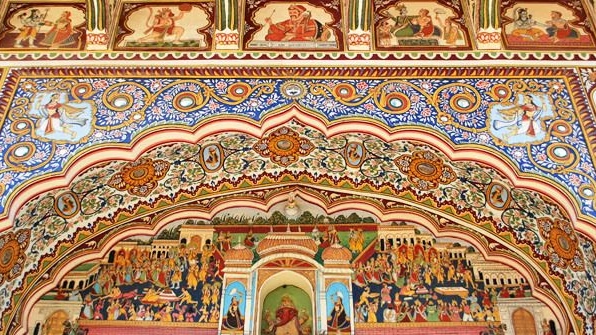
- A Living Canvas of Heritage
- Shekhawati Frescoes are often called the “Open-Air Art Gallery of Rajasthan.”
- Every wall, ceiling, and arch tells a story — painted not just for beauty, but to preserve culture through color.
- Shekhawati Frescoes are often called the “Open-Air Art Gallery of Rajasthan.”
- Storytelling Through Art
- These Shekhawati frescoes narrate epic tales from the Ramayana, Mahabharata, and folk legends, making art the voice of tradition.
- Merchants and nobles once used these paintings to express pride, devotion, and prosperity.
- These Shekhawati frescoes narrate epic tales from the Ramayana, Mahabharata, and folk legends, making art the voice of tradition.
- Fusion of Faith and Daily Life
- Beyond gods and myths, Shekhawati artists painted carriages, trains, animals, and daily life scenes, showing how tradition met modernity on the same wall.
- This blend gives the frescoes a human touch — spiritual yet relatable.
- Beyond gods and myths, Shekhawati artists painted carriages, trains, animals, and daily life scenes, showing how tradition met modernity on the same wall.
- Symbol of Identity and Legacy
- The frescoes became a visual signature of Rajasthan’s Shekhawati region, defining its cultural identity.
- They serve as historic diaries, reflecting how people lived, believed, and dreamed centuries ago.
- The frescoes became a visual signature of Rajasthan’s Shekhawati region, defining its cultural identity.
- Color That Connects Generations
- Painted in natural lime and mineral colors, these works still breathe — alive, vibrant, and timeless, much like the culture they represent.
🖌️ Shekhawati Frescoes – Material Used and Steps of Making
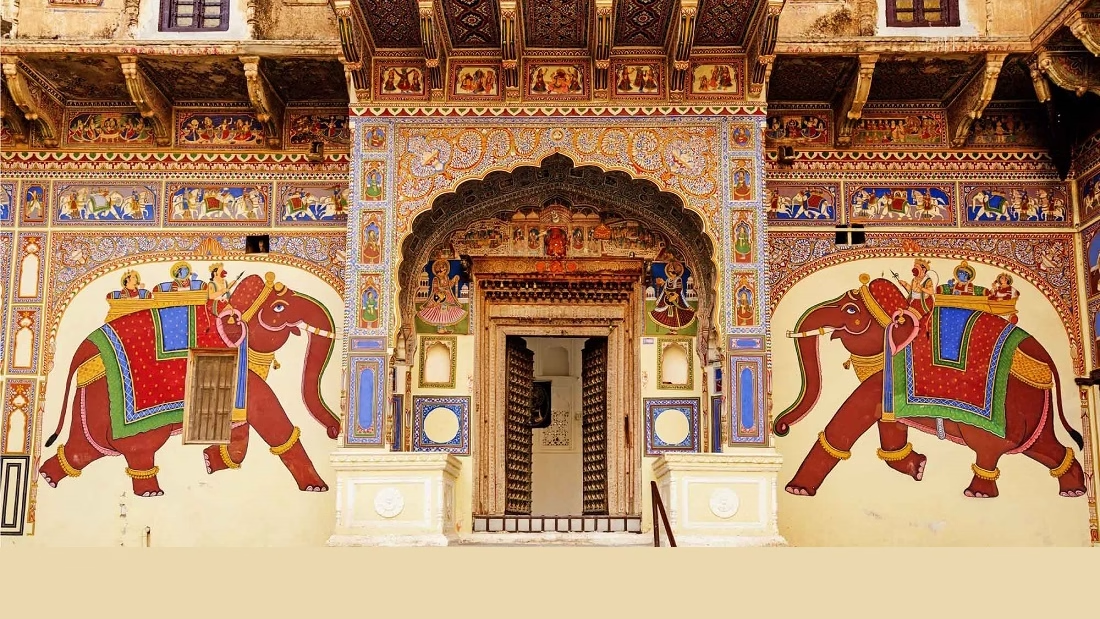
When you walk through the havelis of Shekhawati, every wall feels alive — painted with vibrant scenes of gods, kings, elephants, and daily life. But have you ever wondered how these century-old paintings still glow with life?
Let’s dive into the materials and process that make the Shekhawati Frescoes so breathtaking and long-lasting.
🌿 Materials Used in Shekhawati Frescoes
The artisans of Shekhawati Frescoes were not just painters — they were chemists, storytellers, and visionaries. Everything they used came from nature — no synthetic paints, no modern tools, just pure artistry and wisdom passed through generations.
1. Lime (Chuna) – The Living Canvas
- The walls were first plastered with a fine mixture of lime, sand, and organic fibers (like husk or jute).
- Lime was used instead of cement because it breathed with the wall, allowing moisture to escape, thus preserving the art for centuries.
- When polished with a stone or shell, the lime plaster gave a smooth, glossy surface — a perfect base for painting.
2. Natural Pigments – Colors Born from Earth
- Every color in Shekhawati Frescoes came from natural sources:
- Red and Brown: Made from geru (iron oxide).
- Yellow: From haldi (turmeric) or orpiment stone.
- Green: From copper compounds or crushed leaves.
- Blue: From indigo or lapis lazuli stone.
- Black: From lamp soot or charcoal.
- Red and Brown: Made from geru (iron oxide).
- These pigments were mixed with natural binders like gum, jaggery, or casein (milk protein) to make them stick to the wall.
3. Brushes and Tools – Handmade Precision
- Brushes were made using squirrel or goat hair, tied to bamboo sticks.
- For detailing, artists even used peacock feathers or fine cotton threads.
- Wooden scales and strings were used to draw perfect borders and geometric designs.
4. Binding Agents – Strengthening the Colors
- The artists often used a mix of lime water, buttermilk, and jaggery syrup as a binder.
- This natural glue not only made the paint last longer but also added a soft sheen to the fresco.
🎨 Steps of Making Shekhawati Frescoes
The creation of a fresco was a slow, meditative process — every step carried patience and devotion. Here’s how the artisans brought life to the walls:
1. Wall Preparation – Creating the Canvas
- A rough layer of lime and sand plaster was applied to the wall.
- Once it dried, a second smoother layer of lime plaster was added.
- This layer was slightly moist during painting — a key secret! The colors would merge with the lime as it dried, becoming one with the wall.
2. Sketching the Design – Outlining the Story
- The artist first made rough sketches with charcoal or a thin brush.
- Traditional designs included mythological tales, royal processions, animals, floral vines, and sometimes even trains and clocks (showing modern influences of that era).
3. Color Application – Breathing Life into Art
- Natural pigments were carefully mixed and applied in layers.
- Lighter colors were painted first, followed by darker outlines for definition.
- Artists worked quickly before the plaster dried, as true fresco painting demanded speed and precision.
4. Burnishing and Polishing – The Final Glow
- Once the painting dried, artisans gently rubbed the wall with smooth stones or shells.
- This process gave the fresco its signature shine and durability — the reason why Shekhawati Frescoes still sparkle today.
5. Ornamental Borders and Finishing Touches
- Delicate borders of flowers, creepers, and geometric lines were painted to frame each scene.
- Gold leaf or mica dust was sometimes added for a royal touch, especially in wealthy havelis.
🎨 Symbols and Motifs: The Language of Colors and Patterns
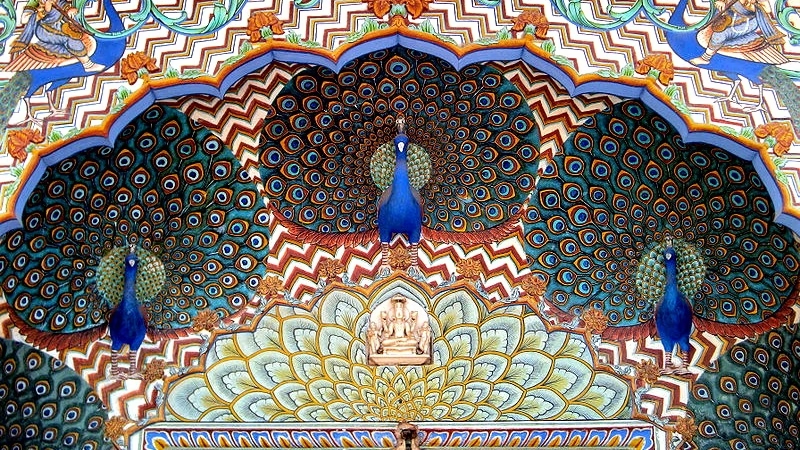
If you’ve ever wandered through the painted havelis of Shekhawati, you know it’s like stepping into a living art museum — every wall whispers a story, every color holds a secret, and every motif speaks of a time when walls were storytellers.
1. Divine Depictions – Gods as Everyday Companions
- The frescoes of Shekhawati often begin and end with Hindu deities, showcasing faith as an inseparable part of daily life.
- Lord Krishna’s Ras Leela and Ramayana scenes dominate the walls — painted not just for devotion but to symbolize love, virtue, and protection.
- Lord Ganesha, the remover of obstacles, often guards the main entrance of havelis, welcoming prosperity.
- Each deity is adorned in bright hues of red, yellow, and blue — colors that signify power, purity, and calmness.
2. Nature as Inspiration – A Canvas of Life and Growth
- Nature is one of the most beloved themes in Shekhawati Frescoes.
- Peacocks, Rajasthan’s pride, represent beauty, love, and monsoon joy.
- Lotus flowers appear frequently — a symbol of purity rising above worldly struggles.
- Elephants and camels, essential companions in desert life, symbolize strength, endurance, and royalty.
- Even trees like banyan and mango find their place, representing longevity, wisdom, and abundance.
- Through these motifs, Shekhawati Frescoes artists celebrated not just nature’s beauty but its deep connection to human emotion and survival.
3. Myth and Folklore – Walls that Speak Stories
- Shekhawati Frescoes are India’s visual storytelling at its best.
- Walls narrate mythological tales from the Mahabharata and Ramayana alongside *local legends and folk heroes.
- Raja Harishchandra’s truthfulness, Dhola-Maru’s love story, and Pabuji’s bravery are painted in sequence like frames from a cinematic saga.
- These scenes reminded residents of moral values, community identity, and pride in Rajasthani folklore.
4. Royal Grandeur – The Pride of Patron Families
- Wealthy merchants (Marwaris) of Shekhawati frescoes commissioned frescoes not only as decoration but as expressions of status and success.
- Palaces, processions, and royal courts filled with elephants, chariots, and courtiers conveyed prosperity.
- Sometimes even British trains, cars, and airplanes were depicted — showing how the region embraced modernity through art.
- These motifs became symbolic of aspiration, progress, and pride in one’s achievements.
5. Cultural Harmony – Colors that Connect Communities
- The color symbolism in Shekhawati Frescoes adds another layer of meaning:
- Red – Energy, marriage, and victory.
- Yellow – Peace, knowledge, and sacredness.
- Blue – Calmness and divine depth.
- Green – Fertility and growth.
- Red – Energy, marriage, and victory.
- The artists created these pigments from natural minerals, flowers, and stones, making every shade a product of the earth itself.
- Each wall thus became a bridge between man, nature, and spirit — alive in color and culture.
6. Everyday Life – Celebrating the Common Man
- Alongside gods and royals, Shekhawati Frescoes beautifully depict ordinary people doing extraordinary things.
- You’ll find women churning butter, men at fairs, musicians playing, and children flying kites.
- These human motifs make the frescoes relatable — reminding us that art doesn’t just belong to kings but to everyone who lives, loves, and dreams.
7. Architectural Harmony – When Art and Structure Unite
- Motifs weren’t randomly placed; every space had meaning.
- Ceilings showed celestial scenes — stars and divine beings watching over.
- Door frames and arches carried floral vines to symbolize welcome and prosperity.
- Courtyards had scenes of celebration, where families gathered, making art an inseparable part of daily life.
8. Timeless Language – Why These Motifs Still Matter
- The symbols of Shekhawati Frescoes are not just relics of the past — they’re lessons painted in lime and color.
- They tell us how art was once a mirror of society — joyful, spiritual, and deeply rooted in its environment.
- Every fresco, whether fading or freshly restored, continues to speak — in colors, in silence, and in spirit.
🌍 Statistics and Global Recognition: Numbers That Tell the Story
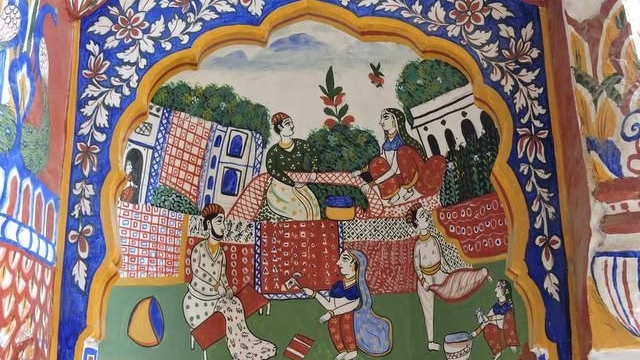
The Shekhawati Frescoes aren’t just a regional treasure — they’re a global marvel painted across time, tradition, and walls. Let’s look at the fascinating facts and figures that reveal their cultural and artistic importance.
🎨 1. The World’s Largest Open-Air Gallery
- The Shekhawati frescoes region in Rajasthan covers around 13,800 square kilometers, dotted with fresco-painted havelis, cenotaphs, and temples.
- Over 2,200 heritage havelis still stand tall across towns like Mandawa, Nawalgarh, Fatehpur, and Dundlod, earning Shekhawati the title “The Open-Air Art Gallery of India.”
🏠 2. A Canvas of History
- These Shekhawati Frescoes date back to the 18th and 19th centuries, painted by local artisans for wealthy merchant families.
- Each haveli contains hundreds of fresco panels, illustrating mythological tales, royal processions, and even early modern inventions like cars and trains!
🌐 3. Global Recognition and Tourism
- The region attracts over 2 lakh visitors every year, including art historians, architects, and travelers from across the world.
- International media often calls it “Rajasthan’s Hidden Gem” and compares its artistry to Italy’s Renaissance wall paintings.
- UNESCO has acknowledged Shekhawati’s unique mural tradition as a vital part of India’s intangible cultural heritage.
🧱 4. Restoration and Conservation in Numbers
- Around 15% of Shekhawati frescoes havelis have undergone restoration supported by Indian and international heritage trusts.
- Local NGOs and art students conduct annual documentation drives, digitally archiving murals before they fade with time.
Conclusion:
Shekhawati Frescoes are not just wall paintings, they are timeless storytellers breathing life into Rajasthan’s golden sands. Every color, every brushstroke whispers tales of valor, devotion, and royal grandeur. As we admire these vibrant murals today, we aren’t just looking at art we’re witnessing history preserved on lime-plastered walls.
The Shekhawati Frescoes stand as a reminder that creativity needs no frame, only passion and purpose. Protecting them isn’t just about saving art—it’s about keeping India’s cultural heartbeat alive, one painted wall at a time.
Also Read: Vastu Shastra in Indian Temple Designs: The Art of Sacred Architecture.

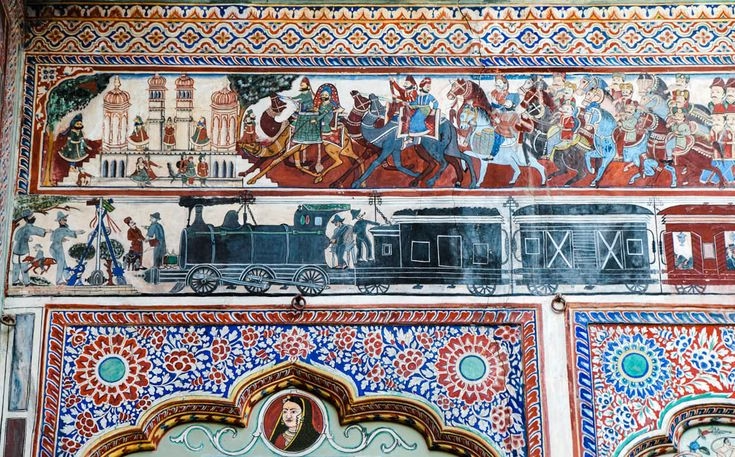
Leave a Reply